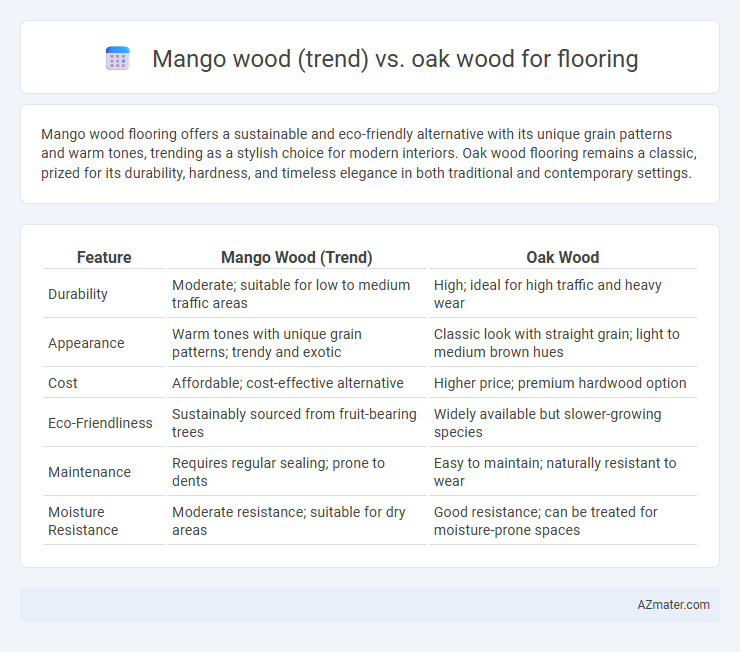Mango wood flooring offers a sustainable and eco-friendly alternative with its unique grain patterns and warm tones, trending as a stylish choice for modern interiors. Oak wood flooring remains a classic, prized for its durability, hardness, and timeless elegance in both traditional and contemporary settings.
Table of Comparison
| Feature | Mango Wood (Trend) | Oak Wood |
|---|---|---|
| Durability | Moderate; suitable for low to medium traffic areas | High; ideal for high traffic and heavy wear |
| Appearance | Warm tones with unique grain patterns; trendy and exotic | Classic look with straight grain; light to medium brown hues |
| Cost | Affordable; cost-effective alternative | Higher price; premium hardwood option |
| Eco-Friendliness | Sustainably sourced from fruit-bearing trees | Widely available but slower-growing species |
| Maintenance | Requires regular sealing; prone to dents | Easy to maintain; naturally resistant to wear |
| Moisture Resistance | Moderate resistance; suitable for dry areas | Good resistance; can be treated for moisture-prone spaces |
Introduction: Mango Wood vs Oak Wood Flooring
Mango wood flooring offers a unique combination of sustainability and affordability, making it a popular trend in eco-conscious home design. Oak wood is prized for its durability, classic grain patterns, and long-lasting strength, often preferred in traditional and high-traffic areas. Comparing mango wood versus oak wood flooring highlights differences in hardness, cost, and environmental impact, with mango wood providing a softer, more affordable alternative and oak delivering superior resilience and timeless appeal.
Popularity and Trends in Flooring Materials
Mango wood is rapidly gaining popularity in flooring due to its sustainability, affordability, and unique grain patterns, appealing to eco-conscious consumers and modern design trends. Oak wood, long favored for its durability and classic aesthetic, remains a top choice in traditional and high-end flooring but faces competition from emerging materials like mango wood. The trend shift towards mango wood reflects growing demand for environmentally friendly and visually distinct flooring options in contemporary interiors.
Origin and Sustainability of Mango and Oak Wood
Mango wood, sourced primarily from India, is a sustainable flooring choice due to its rapid growth and efficient use of mango trees after fruit production declines, reducing deforestation impact. In contrast, Oak wood, native to the Northern Hemisphere including Europe and North America, has a slower growth cycle, making it less sustainable but highly durable. The sustainability of mango wood floors aligns with eco-friendly practices, while oak offers long-term resilience but requires more careful resource management.
Durability and Hardness Comparison
Mango wood offers a unique blend of moderate hardness and durability, making it suitable for flooring in areas with less intense foot traffic compared to oak wood, which is significantly harder and more durable with a Janka hardness rating of approximately 1360 compared to mango's 1070. Oak flooring resists dents and scratches better, making it ideal for high-traffic spaces and long-term wear, while mango wood provides an eco-friendly, sustainable alternative with appealing grain patterns but requires more maintenance to preserve its integrity. Choosing between mango and oak depends on the balance between desired durability, hardness, and aesthetic preference for flooring projects.
Aesthetic Appeal: Color, Grain, and Texture
Mango wood flooring offers a unique aesthetic appeal with its warm golden-orange hues and distinctive irregular grain patterns that create a rustic yet contemporary look. Oak wood flooring features classic, consistent grain patterns with a natural light to medium brown color, providing timeless elegance and versatility for various interior styles. The texture of mango wood is smooth with occasional natural knots, adding character, while oak boasts a tighter grain and harder surface, lending durability and a more uniform finish.
Installation Process and Compatibility
Mango wood flooring offers a faster installation process due to its lighter weight and engineered plank options, which are compatible with underfloor heating systems and various subfloors. Oak wood flooring requires more precise acclimatization and moisture control during installation, often demanding a robust subfloor for stability and ideal compatibility with nail-down or glue-down methods. Both woods are compatible with common installation styles, but mango wood's adaptability and ease of handling make it a favorable choice for quicker renovations.
Maintenance and Longevity
Mango wood flooring offers a sustainable and eco-friendly alternative to traditional hardwoods, with moderate durability and requires regular sealing to prevent moisture damage. Oak wood flooring is renowned for its exceptional hardness and long-lasting resilience, demanding minimal maintenance aside from occasional refinishing to preserve its appearance. Despite mango wood's trendiness and affordability, oak wood remains superior in longevity and ease of upkeep for high-traffic areas.
Cost Comparison: Mango Wood vs Oak Wood
Mango wood flooring typically costs between $4 to $7 per square foot, making it a budget-friendly option compared to oak wood, which ranges from $6 to $12 per square foot depending on the grade and finish. Mango wood offers durability and sustainability at a lower price point, ideal for cost-conscious homeowners seeking an eco-friendly alternative. Oak wood flooring, while more expensive, provides greater hardness and traditional aesthetic appeal, often justifying the higher investment for long-term value.
Environmental Impact and Ethical Considerations
Mango wood flooring is gaining popularity due to its sustainable sourcing from trees that no longer produce fruit, minimizing deforestation compared to traditional hardwoods like oak. Oak wood, while durable, often comes from slower-growing trees, leading to longer replenishment cycles and greater environmental strain. Choosing mango wood supports ethical forestry practices by utilizing a byproduct of fruit farming, thereby reducing waste and promoting responsible land use.
Conclusion: Choosing the Ideal Flooring for Your Home
Mango wood offers a sustainable and eco-friendly alternative to traditional hardwoods, with its unique grain patterns and affordability appealing to modern homeowners. Oak wood remains a classic choice known for its durability, timeless beauty, and resistance to wear, making it ideal for high-traffic areas. Selecting the ideal flooring depends on balancing sustainability, aesthetic preferences, budget, and the desired longevity of the material in your home.

Infographic: Mango wood (trend) vs Oak wood for Flooring
 azmater.com
azmater.com